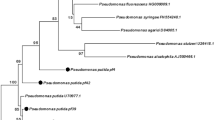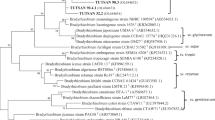Abstract
Certain strains of the rhizosphere bacterium Pseudomonas fluorescens contain the phenazine biosynthesis operon (phzABCDEFG) and produce redox-active phenazine antibiotics that suppress a wide variety of soilborne plant pathogens. In 2007 and 2008, we isolated 412 phenazine-producing (Phz+) fluorescent Pseudomonas strains from roots of dryland wheat and barley grown in the low-precipitation region (<350 mm annual precipitation) of central Washington State. Based on results of BOX-PCR genomic fingerprinting analysis, these isolates, as well as the model biocontrol Phz+ strain P. fluorescens 2-79, were assigned to 31 distinct genotypes separated into four clusters. All of the isolates exhibited high 16S rDNA sequence similarity to members of the P. fluorescens species complex including Pseudomonas orientalis, Pseudomonas gessardii, Pseudomonas libanensis, and Pseudomonas synxantha. Further recA-based sequence analyses revealed that the majority of new Phz+ isolates (386 of 413) form a clade distinctly separated from P. fluorescens 2-79. Analysis of phzF alleles, however, revealed that the majority of those isolates (280 of 386) carried phenazine biosynthesis genes similar to those of P. fluorescens 2-79. phzF-based analyses also revealed that phenazine genes were under purifying selection and showed evidence of intracluster recombination. Phenotypic analyses using Biolog substrate utilization and observations of phenazine-1-carboxylic acid production showed considerable variability amongst members of all four clusters. Biodiversity indices indicated significant differences in diversity and evenness between the sampled sites. In summary, this study revealed a genotypically and phenotypically diverse group of phenazine producers with a population structure not seen before in indigenous rhizosphere-inhabiting Phz+ Pseudomonas spp.





Similar content being viewed by others
References
Lugtenberg B, Kamilova F (2009) Plant growth-promoting rhizobacteria. Annu Rev Microbiol 63:541–556. doi:10.1146/annurev.micro.62.081307.162918
Mavrodi DV, Mavrodi OV, Parejko JA, Weller DM, Thomashow LS (2011) The role of 2,4-diacetylphloroglucinol- and phenazine-1-carboxylic acid-producing Pseudomonas spp. in natural protection of wheat from soilborne pathogens. In: Bacteria in Agrobiology: Plant Nutrient Management, 1st ed. Springer: Berlin. pp 267–283
Mavrodi DV et al (2010) Diversity and evolution of the phenazine biosynthesis pathway. Appl Environ Microbiol 76:866–879. doi:10.1128/AEM.02009-09
Thomashow LS, Weller DM (1988) Role of a phenazine antibiotic from Pseudomonas fluorescens in biological control of Gaeumannomyces graminis var. tritici. J Bacteriol 170:3499–3508
Thomashow LS, Weller DM, Bonsall RF, Pierson LS (1990) Production of the antibiotic phenazine-1-carboxylic acid by fluorescent Pseudomonas species in the rhizosphere of wheat. Appl Environ Microbiol 56:908–912
Chin-A-Woeng TFC et al (1998) Biocontrol by phenazine-1-carboxamide-producing Pseudomonas chlororaphis PCL1391 of tomato root rot caused by Fusarium oxysporum f. sp.radicis-lycopersici. Mol Plant Microbe Interact 11:1069–1077. doi:10.1094/MPMI.1998.11.11.1069
Mazurier S, Corberand T, Lemanceau P, Raaijmakers JM (2009) Phenazine antibiotics produced by fluorescent pseudomonads contribute to natural soil suppressiveness to Fusarium wilt. ISME J 3:977–991
Perneel M et al (2008) Phenazines and biosurfactants interact in the biological control of soil-borne diseases caused by Pythium spp. Environ Microbiol 10:778–788. doi:10.1111/j.1462-2920.2007.01501.x
Fernando WG, Pierson LS (1999) The effect of increased phenazine antibiotic production on the inhibition of economically important soil-borne plant pathogens by Pseudomonas aureofaciens 30-84. Arch Phytopath Plant Prot 32:491–502
Mavrodi DV, Blankenfeldt W, Thomashow LS (2006) Phenazine compounds in fluorescent Pseudomonas spp. biosynthesis and regulation. Annu Rev Phytopathol 44:417–445
D’aes J et al (2011) Biological control of Rhizoctonia root rot on bean by phenazine- and cyclic lipopeptide-producing Pseudomonas CMR12a. Phytopathology 101:996–1004. doi:10.1094/PHYTO-11-10-0315
Yang MM et al (2011) Biological control and mechanisms of suppression of take-all by fluorescent Pseudomonas spp. from Chinese wheat fields. Phytopathology 101:1481–1491
Mavrodi DV et al (2011) Accumulation of the antibiotic phenazine-1-carboxylic acid in the rhizosphere of dryland cereals. Appl Environ Microbiol. doi:10.1128/AEM.06784-11
Schillinger WF, Paulitz TC (2006) Reduction of Rhizoctonia bare patch in wheat with barley rotations. Plant Dis 90:302–306
McSpadden Gardener BB, Mavrodi DV, Thomashow LS, Weller DM (2001) A rapid polymerase chain reaction-based assay characterizing rhizosphere populations of 2,4-diacetylphloroglucinol-producing bacteria. Phytopathology 91:44–54. doi:10.1094/PHYTO.2001.91.1.44
Mavrodi OV et al (2001) Genetic diversity of phlD from 2,4-diacetylphloroglucinol-producing fluorescent Pseudomonas spp. Phytopathology 91:35–43. doi:10.1094/PHYTO.2001.91.1.35
Ausubel FM et al (2002) Short protocols in molecular biology, 5th edn. Wiley, New York
Versalovic J, Schneider M, De Bruijn F, Lupski J (1994) Genomic fingerprinting of bacteria using repetitive sequence-based polymerase chain reaction. Meth Mol Cell Biol 5:25–40
Kogan SC, Doherty M, Gitschier J (1987) An improved method for prenatal diagnosis of genetic diseases by analysis of amplified DNA sequences. Application to hemophilia A. N Engl J Med 317:985–990. doi:10.1056/NEJM198710153171603
Rademaker JLW, de Bruijn FJ (1997) Characterization and classification of microbes by rep-PCR genomic fingerprinting and computer assisted pattern analysis. In: Caetano-Anollés G, Gresshoff PM (eds) DNA markers: protocols, applications and overviews. Wiley, New York, pp 151–171
Hill TCJ, Walsh KA, Harris JA, Moffett BF (2003) Using ecological diversity measures with bacterial communities. FEMS Microbiol Ecol 43:1–11. doi:10.1111/j.1574-6941.2003.tb01040.x
Oksanen J et al. (2011) vegan: Community ecology package. http://CRAN.R-project.org/package=vegan
Kindt R, Coe R (2005) Tree diversity analysis. A manual and software for common statistical methods for ecological and biodiversity studies. World Agroforestry Centre (ICRAF), Nairobi
Bergsma-Vlami M, Prins ME, Raaijmakers JM (2005) Influence of plant species on population dynamics, genotypic diversity and antibiotic production in the rhizosphere by indigenous Pseudomonas spp. FEMS Microbiol Ecol 52:59–69
Weisburg WG, Barns SM, Pelletier DA, Lane DJ (1991) 16S ribosomal DNA amplification for phylogenetic study. J Bacteriol 173:697–703
Tamura K et al (2011) MEGA5: Molecular evolutionary genetics analysis using maximum likelihood, evolutionary distance, and maximum parsimony methods. Mol Biol Evol 10:2731–2739
Huson DH, Bryant D (2006) Application of phylogenetic networks in evolutionary studies. Mol Biol Evol 23:254–267. doi:10.1093/molbev/msj030
Kimura M (1980) A simple method for estimating evolutionary rates of base substitutions through comparative studies of nucleotide sequences. J Mol Evol 16:111–120
Gascuel O (1997) BIONJ: an improved version of the NJ algorithm based on a simple model of sequence data. Mol Biol Evol 14:685–695
Jones DT, Taylor WR, Thornton JM (1992) The rapid generation of mutation data matrices from protein sequences. Comput Appl Biosci 8:275–282
Bruen TC, Philippe H, Bryant D (2006) A simple and robust statistical test for detecting the presence of recombination. Genetics 172:2665–2681. doi:10.1534/genetics.105.048975
Librado P, Rozas J (2009) DnaSP v5: a software for comprehensive analysis of DNA polymorphism data. Bioinformatics 25:1451–1452. doi:10.1093/bioinformatics/btp187
Nei M, Gojobori T (1986) Simple methods for estimating the numbers of synonymous and nonsynonymous nucleotide substitutions. Mol Biol Evol 3:418–426
Tang J, Hanage WP, Fraser C, Corander J (2009) Identifying currents in the gene pool for bacterial populations using an integrative approach. PLoS Comput Biol 5:e1000455. doi:10.1371/journal.pcbi.1000455
Alisi C et al (2005) Metabolic profiling of Burkholderia cenocepacia, Burkholderia ambifaria, and Burkholderia pyrrocinia isolates from maize rhizosphere. Microb Ecol 50:385–395. doi:10.1007/s00248-005-0223-y
King EO, Ward MK, Raney DE (1954) Two simple media for the demonstration of pyocyanin and fluorescin. J Lab Clin Med 44:301–307
Bonsall R, Weller D, Thomashow L (1997) Quantification of 2,4-diacetylphloroglucinol produced by fluorescent Pseudomonas spp. in vitro and in the rhizosphere of wheat. Appl Environ Microbiol 63:951–955
Khan SR et al (2005) Activation of the phz operon of Pseudomonas fluorescens 2-79 requires the LuxR homolog PhzR, N-(3-oh-hexanoyl)-l-homoserine lactone produced by the LuxI homolog PhzI, and a cis-acting phz box. J Bacteriol 187:6517–6527. doi:10.1128/JB.187.18.6517-6527.2005
Nei M, Kumar S (2000) Molecular evolution and phylogenetics, 1st edn. Oxford University Press, New York, NY
Dabboussi F et al (1999) Taxonomic study of bacteria isolated from Lebanese spring waters: proposal for Pseudomonas cedrella sp. nov. and P. orientalis sp. nov. Res Microbiol 150:303–316. doi:10.1016/S0923-2508(99)80056-4
Dabboussi F et al (1999) Pseudomonas libanensis sp. nov., a new specie isolated from Lebanese spring waters. Int J Syst Bacteriol 49:1091–1101. doi:10.1099/00207713-49-3-1091
Vančura V (1964) Root exudates of plants. Plant Soil 21:231–248. doi:10.1007/BF01373607
Rovira A (1969) Plant root exudates. Bot Rev 35:35–57. doi:10.1007/BF02859887
Berg G, Smalla K (2009) Plant species and soil type cooperatively shape the structure and function of microbial communities in the rhizosphere. FEMS Microbiol Ecol 68:1–13. doi:10.1111/j.1574-6941.2009.00654.x
Marschner P, Yang C-H, Lieberei R, Crowley DE (2001) Soil and plant specific effects on bacterial community composition in the rhizosphere. Soil Biol Biochem 33:1437–1445. doi:10.1016/S0038-0717(01)00052-9
Raaijmakers JM, de Bruijn I, de Kock MJD (2006) Cyclic lipopeptide production by plant-associated Pseudomonas spp.: diversity, activity, biosynthesis, and regulation. Mol Plant Microbe Interact 19:699–710
Mazzola M, Cook RJ, Thomashow LS, Weller DM, Pierson LSI (1992) Contribution of phenazine antibiotic biosynthesis to the ecological competence of fluorescent pseudomonads in soil habitats. Appl Environ Microbiol 58:2616–2624
Demanèche S, Kay E, Gourbière F, Simonet P (2001) Natural transformation of Pseudomonas fluorescens and Agrobacterium tumefaciens in soil. Appl Environ Microbiol 67:2617–2621. doi:10.1128/AEM.67.6.2617-2621.2001
Acknowledgments
The project described was supported by award number T32GM083864 from the National Institute of General Medical Sciences. The content is solely the responsibility of the authors and does not necessarily represent the official views of the National Institute of General Medical Sciences or the National Institutes of Health.
Author information
Authors and Affiliations
Corresponding author
Additional information
USDA is an equal opportunity provider and employer.
Electronic Supplementary Material
Below is the link to the electronic supplementary material.
ESM Table 1
Distribution of BOX-PCR genotypes throughout sampling sites (PDF 24 kb)
ESM Table 2
Population-wide recA and phzF nucleotide sequence distance (a) and diversity calculations (b; PDF 25 kb)
ESM Table 3
Sixty-two (as determined by principle components analysis) Biolog substrates used for cluster analysis (PDF 261 kb)
ESM Table 4
Utilization data for 17 common wheat rhizosphere exudates extracted from Biolog GN2 microplate dataset (PDF 142 kb)
ESM Table 5
Production of phenazine-1-carboxylic acid and biosurfactants by 31 Phz+ genotypes (PDF 20 kb)
Rights and permissions
About this article
Cite this article
Parejko, J.A., Mavrodi, D.V., Mavrodi, O.V. et al. Population Structure and Diversity of Phenazine-1-Carboxylic Acid Producing Fluorescent Pseudomonas spp. from Dryland Cereal Fields of Central Washington State (USA). Microb Ecol 64, 226–241 (2012). https://doi.org/10.1007/s00248-012-0015-0
Received:
Accepted:
Published:
Issue Date:
DOI: https://doi.org/10.1007/s00248-012-0015-0




